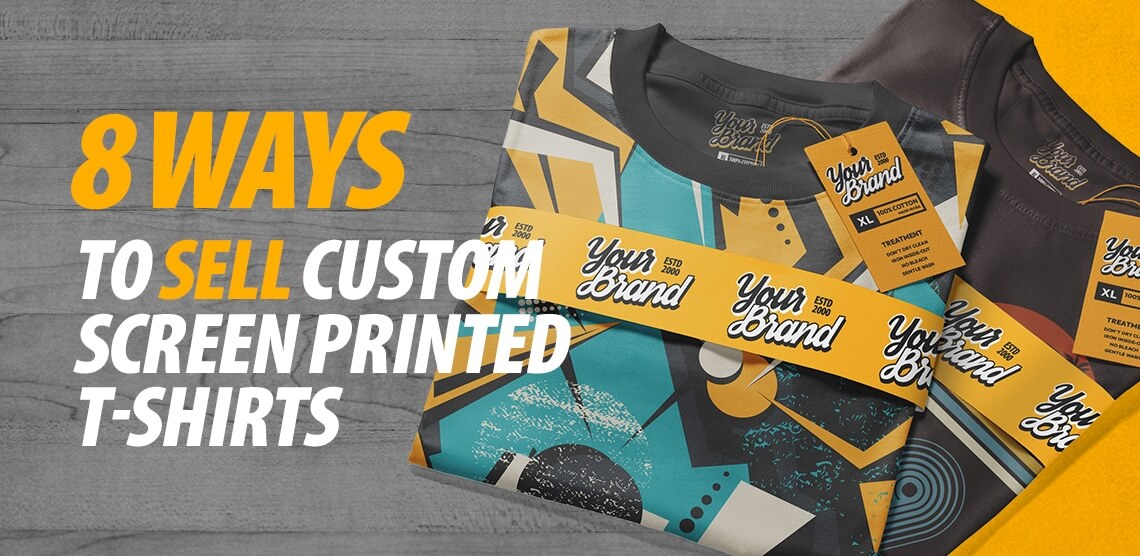Affordable Screen Printing Kit for Home Use
Wiki Article
Screen Printing Uncovered: Whatever You Required to Know Regarding Tee Shirt and Garment Printing Methods
Screen printing is a remarkable approach that incorporates art with method, offering countless possibilities for creativity. Prepared to discover the necessary elements that make display printing an art type?
The Essentials of Display Printing: How It Functions
When you dive right into screen printing, you'll discover it's both a science and an art. At its core, screen printing includes creating a stencil, or screen, that enables ink to pass with just in specific locations.Position the display over the textile, then utilize a squeegee to press ink through the display onto the garment. Each step is necessary, and understanding them will boost your display printing skills, changing easy garments right into special, expressive pieces.
Sorts Of Screen Printing Strategies
As soon as you grasp the essentials of display printing, it's time to check out the different strategies that can elevate your layouts. One popular technique is conventional display printing, where ink is pushed with a stenciled screen. This technique is great for vibrant, vivid shades. There's water-based ink printing, which offers a softer feeling and is green, however it requires a different approach to curing.One more choice is plastisol printing, understood for its resilience and vivid colors, making it a preferred for numerous brands. Experiment with halftone printing to produce gradient effects and complex layouts.
Vital Devices for Screen Printing
To attain sensational outcomes in display printing, having the ideal equipment is fundamental. You'll require a durable display printing structure, which holds the mesh that transfers your layout onto the garment. Next, invest in top notch squeegees; these are important for applying ink uniformly throughout the screen.Selecting the Right Inks and Products
When picking inks and products for display printing, you require to take into account the sort of ink that works ideal for your project. Consider textile compatibility to assure your designs look excellent and last long. Likewise, check out environment-friendly ink options to make your printing procedure more sustainable.Sorts Of Screen Inks
Choosing the best screen ink is crucial for attaining lively, long lasting prints that meet your task's demands. There are a number of types of screen inks to analyze. Plastisol ink is preferred for its convenience and ease of usage, supplying excellent color opacity on dark textiles. Water-based ink, on the other hand, uses a softer feel and is green, making it suitable for those aiming to decrease their environmental impact. Discharge inks remove dye from the textile, causing a soft, classic appearance but call for particular handling. Specialty inks, such as glow-in-the-dark or metal, can include one-of-a-kind results to your designs. Assess your job demands and choose the ink that aligns ideal with your wanted result.
Textile Compatibility Factors To Consider
Comprehending material compatibility is essential for achieving top notch display prints, particularly since different products react distinctively to different inks. When picking inks, take into consideration the textile kind-- cotton, polyester, or blends. For cotton, water-based inks work well, providing gentleness and breathability. Polyester, on the various other hand, usually calls for plastisol inks for better attachment and dynamic shades. You might need to utilize a mix of both kinds if you're printing on blends. Constantly evaluate your inks on sample fabric to guarantee they stick correctly and maintain shade stability. Furthermore, maintain in mind that material weight and texture can affect the last result, so choosing the right ink and material combination is essential for your job's success.Eco-Friendly Ink Options
Eco-friendly inks are ending up being a prominent choice for display printers that desire to minimize their ecological impact while preserving top quality. When choosing inks, think about water-based inks, which are less harmful and much easier to cleanse up contrasted to standard solvents.Furthermore, seek inks made from renewable resources, such as soy or vegetable-based choices. By picking the right inks and products, you'll not just develop sensational designs yet additionally add to an extra sustainable printing process. Make the switch, and your prints will certainly reflect your commitment to the atmosphere!
Preparing Your Design for Display Printing

File Layout Demands
To guarantee your layout looks sharp and dynamic on fabric, you'll need to pay close attention to submit layout demands for display printing. Make sure your style has a clear history to stop undesirable white sides on your prints. Maintain shade modes in mind; CMYK is basic for display printing, so transform your RGB develops appropriately.Shade Splitting Up Techniques
Color splitting up is a necessary action in preparing your layout for screen printing, and grasping it can significantly enhance your print top quality. You'll need to break your style right into individual colors, as each shade calls for a separate display during printing. Beginning by determining all the colors in your layout and produce layers each. You can use software program like Adobe Photoshop or Illustrator to separate and different colors efficiently. Be particular to conserve each layer as a separate data, typically in a style like TIFF or PSD. This accuracy not only guarantees exact shade depiction yet also simplifies the printing procedure. By paying attention to shade separation, you'll attain dynamic and expert outcomes in your screen-printed garments.Resolution and Size
Accomplishing the most effective lead to screen printing starts with guaranteeing your layout has the ideal resolution and dimension. Preferably, your art work ought to be at least 300 DPI (dots per inch) for right here sharp, clear prints. If you utilize reduced resolution, your final product might look pixelated and less than professional.When it pertains to size, think about the dimensions of your print area. Style your artwork to match the final print dimension, ideally producing it in the actual dimensions you'll be printing. In this manner, you'll prevent any type of unanticipated scaling concerns.
Constantly check your layout in both vector and raster layouts. Vector graphics can be scaled without shedding top quality, making them ideal for display printing. Preparing correctly will guarantee your style looks remarkable on every garment!
Step-by-Step Display Printing Process
Screen printing is a dynamic process that enables you to create vivid styles on different surface areas. To obtain started, you'll need a screen, emulsion, and your selected ink.After rinsing the unexposed solution, your screen prepares. Set it up on your printing surface area and straighten your garment under it. Pour ink onto the screen and use a squeegee to push the ink with the stencil onto the fabric. Raise the display very carefully and let the print dry. Treat the ink using warmth to assure toughness. That's it! You've effectively display printed your layout.
Tips for Effective Screen Printing Projects
While you're diving right into your screen printing tasks, keep in mind that preparation is vital to success. Start by gathering all your materials-- inks, screens, squeegees, and garments. A tidy workspace assists protect against unwanted errors, so clean up prior to you begin.Next, validate your art work is high-resolution and appropriately sized for your garment. Examine your display for correct direct exposure and tidy it thoroughly to prevent smudges. When mixing your inks, comply with the maker's standards to achieve the ideal consistency.
During printing, apply also stress with your squeegee for regular results. Do not rush; take your time to verify each print meets your standards. After printing, let your garments dry entirely before handling or packaging them.
next Finally, always maintain an example of your help future referral. In this manner, you can evaluate your development and improve your strategies over time. Satisfied printing!

Frequently Asked Inquiries
How much time Does It Require To Set up a Display Printing Task?
Establishing a display printing task generally takes around thirty minutes to an hour. You'll prepare the displays, mix inks, and adjust the press. The moment varies based on intricacy and experience, so remain organized!Can I Print on Different Material Keys In Making Use Of the Same Strategy?
Yes, you can publish on various material types utilizing the same technique, yet you'll require to change your inks and setups. Some materials soak up ink differently, so trying out guarantees the best outcomes for each product.What Prevail Mistakes to Prevent in Screen Printing?
When screen printing, prevent usual mistakes like using the incorrect ink, overlooking correct direct exposure times, or avoiding pre-press checks. Constantly test your setup and preserve tidy displays to assure top quality results each time.Just How Can I Correctly Clean and Preserve My Display Printing Equipment?
To correctly clean and keep your screen printing tools, you need to routinely wash displays with suitable solvents, examine squeegees for wear, and ensure all devices are stored dust-free and completely dry. Uniformity stops costly repair work and improves performance.Is Screen Printing Eco-friendly Compared to Other Approaches?
Screen printing can be more eco-friendly than other techniques, particularly if you utilize eco-conscious materials and water-based inks. By choosing lasting materials and practices, you minimize waste and lessen your influence on the earth.Display Printing Uncovered: Every Little Thing You Required to Know Concerning Tee and Garment Printing Techniques
At its core, screen printing involves developing a stencil, or display, that permits ink to pass via just in details locations. Setting the click for more info display over the fabric, after that use a squeegee to push ink via the screen onto the garment. One preferred technique is conventional screen printing, where ink is pressed through a stenciled screen.When picking inks and materials for screen printing, you require to take right into account the type of ink that functions ideal for your task.
Report this wiki page